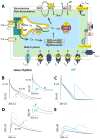Human atrial fibrillation: insights from computational electrophysiological models
- PMID: 22732550
- PMCID: PMC3384487
- DOI: 10.1016/j.tcm.2012.04.004
Human atrial fibrillation: insights from computational electrophysiological models
Abstract
Computational electrophysiology has proven useful to investigate the mechanisms of cardiac arrhythmias at various spatial scales, from isolated myocytes to the whole heart. This article reviews how mathematical modeling has aided our understanding of human atrial myocyte electrophysiology to study the contribution of structural and electrical remodeling to human atrial fibrillation. Potential new avenues of investigation and model development are suggested.
Copyright © 2011 Elsevier Inc. All rights reserved.
Figures



Similar articles
-
Computational models of atrial cellular electrophysiology and calcium handling, and their role in atrial fibrillation.J Physiol. 2016 Feb 1;594(3):537-53. doi: 10.1113/JP271404. Epub 2015 Dec 28. J Physiol. 2016. PMID: 26582329 Free PMC article. Review.
-
Mathematical approaches to understanding and imaging atrial fibrillation: significance for mechanisms and management.Circ Res. 2014 Apr 25;114(9):1516-31. doi: 10.1161/CIRCRESAHA.114.302240. Circ Res. 2014. PMID: 24763468 Free PMC article. Review.
-
Fibrotic Remodeling during Persistent Atrial Fibrillation: In Silico Investigation of the Role of Calcium for Human Atrial Myofibroblast Electrophysiology.Cells. 2021 Oct 22;10(11):2852. doi: 10.3390/cells10112852. Cells. 2021. PMID: 34831076 Free PMC article.
-
Effects of electrical and structural remodeling on atrial fibrillation maintenance: a simulation study.PLoS Comput Biol. 2012;8(2):e1002390. doi: 10.1371/journal.pcbi.1002390. Epub 2012 Feb 23. PLoS Comput Biol. 2012. PMID: 22383869 Free PMC article.
-
Cellular and molecular mechanisms of atrial arrhythmogenesis in patients with paroxysmal atrial fibrillation.Circulation. 2014 Jan 14;129(2):145-156. doi: 10.1161/CIRCULATIONAHA.113.006641. Epub 2013 Nov 18. Circulation. 2014. PMID: 24249718 Free PMC article.
Cited by
-
In Silico Assessment of Efficacy and Safety of IKur Inhibitors in Chronic Atrial Fibrillation: Role of Kinetics and State-Dependence of Drug Binding.Front Pharmacol. 2017 Nov 7;8:799. doi: 10.3389/fphar.2017.00799. eCollection 2017. Front Pharmacol. 2017. PMID: 29163179 Free PMC article.
-
Populations of in silico myocytes and tissues reveal synergy of multiatrial-predominant K+ -current block in atrial fibrillation.Br J Pharmacol. 2020 Oct;177(19):4497-4515. doi: 10.1111/bph.15198. Epub 2020 Aug 9. Br J Pharmacol. 2020. PMID: 32667679 Free PMC article.
-
A calcium transport mechanism for atrial fibrillation in Tbx5-mutant mice.Elife. 2019 Mar 21;8:e41814. doi: 10.7554/eLife.41814. Elife. 2019. PMID: 30896405 Free PMC article.
-
Sodium-calcium exchangers (NCX): molecular hallmarks underlying the tissue-specific and systemic functions.Pflugers Arch. 2014 Jan;466(1):43-60. doi: 10.1007/s00424-013-1405-y. Epub 2013 Nov 27. Pflugers Arch. 2014. PMID: 24281864 Review.
-
Potassium currents in the heart: functional roles in repolarization, arrhythmia and therapeutics.J Physiol. 2017 Apr 1;595(7):2229-2252. doi: 10.1113/JP272883. Epub 2017 Jan 5. J Physiol. 2017. PMID: 27808412 Free PMC article. Review.
References
-
- Ashihara T, Haraguchi R, Nakazawa K, Namba T, Ikeda T, Nakazawa Y, Ozawa T, Ito M, Horie M, Trayanova NA. The role of fibroblasts in complex fractionated electrograms during persistent/permanent atrial fibrillation: implications for electrogram-based catheter ablation. Circ Res. 2012;110:275–84. - PMC - PubMed
-
- Caballero R, de la Fuente MG, Gómez R, Barana A, Amorós I, Dolz-Gaitón P, Osuna L, Almendral J, Atienza F, Fernández-Avilés F, et al. In Humans, Chronic Atrial Fibrillation Decreases the Transient Outward Current and Ultrarapid Component of the Delayed Rectifier Current Differentially on Each Atria and Increases the Slow Component of the Delayed Rectifier Current in Both. Journal of the American College of Cardiology. 2010;55:2346–2354. - PubMed
Publication types
MeSH terms
Grants and funding
LinkOut - more resources
Full Text Sources
Medical

